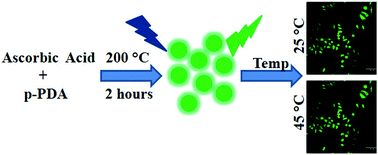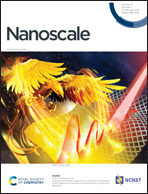Water-soluble green-emitting carbon nanodots with enhanced thermal stability for biological applications†
Abstract
High stability and water solubility of fluorescent nanomaterials are considered key factors to evaluate their feasibility for fundamental applications. Herein, water-soluble and thermally stable, green-emitting carbon nanodots (CNDs) have been synthesized via a facile hydrothermal method with an average size of 1.9 nm. CNDs showed green emission centered at 544 nm with the photo-luminescence quantum yield (PLQY) of up to 10.1% under the excitation of 400 nm. The obtained CNDs demonstrated high resistance towards photo-bleaching and an ionic (KCl) environment. Moreover, the aqueous solution of CNDs exhibited excellent stability under harsh thermal conditions from 10 °C to 80 °C. The as-prepared CNDs showed stable performance at high temperatures, even after keeping them at 80 °C for 30 min. Furthermore, the green emissive CNDs were incubated in T-ca cancer cells for bio-imaging applications. The results indicated that CNDs can served as an effective thermally-stable bio-imaging agent in T-ca cells at the physiological temperature range of 25 °C–45 °C. Green emission and excellent thermal stability make these CNDs promising fluorescent materials for potential applications in the medical field, which requires long-wavelength fluorescence and high-temperature imaging.

- This article is part of the themed collection: Nanoscale and Nanoscale Horizons: Carbon-based nanomaterials


 Please wait while we load your content...
Please wait while we load your content...